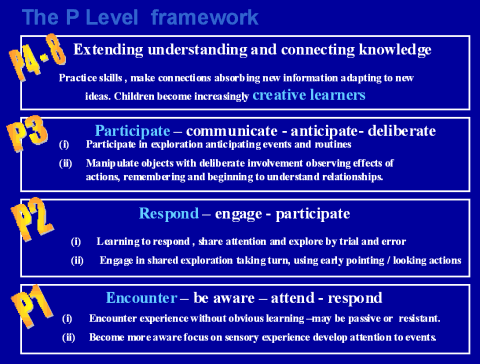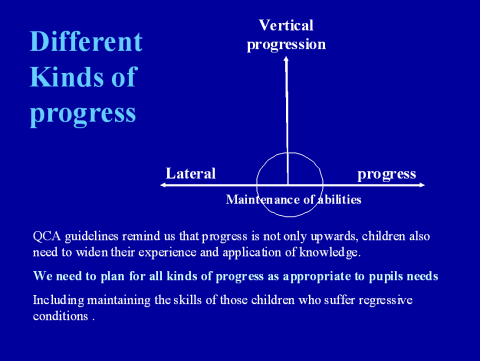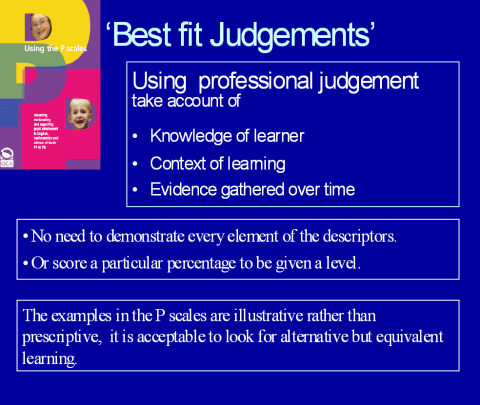The process of making assessments and talking to each other about levels, particularly around P levels 1 to 3 is made much easier if we think back to the wordings in the descriptions from which the P scales were developed.
The table reproduced below from page 27 of the “General guidelines” booklet of the Qualifications and Curriculum Authority (QCA) guidance series “Planning teaching and assessing the curriculum for pupils with learning difficulties” (order ref QCA/01/736 was part of the resources used in first developing P Levels.
It is still useful now for illustrating common sense interpretations.
It is worth noting that it was also a key element used in Ofsted training related to assessing the achievement and progress of pupils with profound learning difficulties.
Recognising Attainment
The framework below can help teachers recognise attainment levels below level 1 of the National Curriculum. It describes possible changes in individual pupils’ responses and behaviour as their early perception of experiences and their increasing involvement in the learning process develop into areas of knowledge, skills and understanding. The development of internal learning processes, for example, thinking skills, is shown by degrees of attention, discrimination and participation in experiences and activities.
| A framework for recognising attainment |
| Encounter |
Pupils are present during an experience or activity without any obvious learning outcome, although for some pupils, for example, those who withold their attention or their presence from many situations, their willingness to tolerate a shared activity may, in itself, be significant. |
| Awareness |
Pupils appear to show awareness that something has happened and notice, fleetingly focus on or attend to object, event or person, for example, by briefly interrupting a pattern of self-absorbed movement or vocalisation. |
Attention and
Response |
Pupils attend and begin to respond, often not consistently, to what is happening , for example, showing signs of surprise, enjoyment, frustration or dissatisfaction, demonstrating the beginning of an ability to distinguish between different people, objects, events and places. |
| Engagement |
Pupils show more consistent attention to, and can tell the difference between, specific events in their surroundings, for example, by focussed looking or listening; turning to locate objects, events or people; following moving objects and events through movements of their eyes, head or other body parts. |
| Participation |
Pupils engage in sharing, taking turns and the anticipation of familiar sequences of events, for example, by smiling, vocalising or showing other signs of excitement, although these responses may be supported by staff or other pupils. |
| Involvement |
Pupils actively strive to reach out, join in or comment in some way on the activity itself or on the actions or responses of the other pupils, for example, by making exploratory hand and arm movements, seeking eye contact with staff or other pupils, or by speaking, signing or gesturing. |
Gaining skills
and
understanding |
Pupils gain, strengthen or make general use of their skills, knowledge, concepts or understanding that relate to their experience of the curriculum, for example, they can recognise the features of an object and understand its relevance, significance and use. |
Readers will note that the table begins by describing a level on which children may only be “encountering” experiences; they may show little response without any obvious learning outcome. This description may have resonance for staff working with a wide range of pupils who are extremely hard to reach – ranging across those who are slipping in and out of consciousness through the effects of epilepsy or medications, to others whose extreme autism leaves them unwilling to tolerate shared activities leading them to withdraw attention. Many young pupils will mature and generally move to higher levels of awareness but some pupils who are profoundly affected by their conditions may be prone to shift in and out of the encounter level throughout their lives.
A second level on the table describes the beginning of “awareness”, and that is followed by a level characterised by beginning to “attend and respond”. The table continues through small but significant steps that describe developing; “engagement – participation — involvement”; towards more sophisticated levels of “gaining skills and understanding”.
If one considers this table alongside P level descriptors for levels P 1 to P3 you can see the relationship. Between its wording and the words used in the performance descriptions.
- P1 ranges from “Encounter” through developing “awareness”; begining to “attend” and “respond”.
- P2 ranges from “Responding” more consistently – through developing the inclination to become “engaged” in joint activities learning to cooperate, communicate preferences and “participate” in exploration with support.
- P3 is characterised as pupils “Participate” with less support developing intentional and more conventional communication, “anticipating” initiating sustaining activities, beginning to be “deliberate” in their explorations and starting to show some understanding of actions.
The diagram below attempts to offer a visual representation of the levels which illustrates that the way the P scales recognise that there is no absolute or hard edge to levels. The wording supports a view that there is overlap and lateral progression within levels.
Beginning to be “responsive” in the sense observed by P1 descriptors is the beginning of working at P2 and “participation” beginning across the P2 range develops towards P3, the nature of our learners means they ebb and flow and we have to assess through observations over time making use of best fit judgements that use professional knowledge.



